
The Nasdaq Helsinki, formerly known as the Helsinki Stock Exchange, is a stock exchange located in Helsinki, Finland. Since 3 September 2003, it has been part of Nasdaq Nordic. After the OMX merger, it was referred to as OMX Helsinki (OMXH), then after NASDAQ's acquisition of OMX in February 2008, NASDAQ OMX Helsinki, and currently Nasdaq Helsinki.

Helsinki has a total area of 686 km2 (265 sq mi). 186 km2 (72 sq mi) of it is land and 500 km2 (190 sq mi) of the area is covered with water. It is located at 60°10′N24°56′E.

Töölö is the collective name for the neighbourhoods Etu-Töölö and Taka-Töölö in Helsinki, Finland. The neighbourhoods are located next to the city centre, occupying the western side of the Helsinki Peninsula.
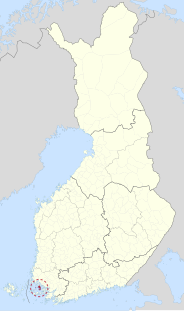
Rymättylä is a former municipality of Finland. It was, together with Merimasku and Velkua, consolidated with the town of Naantali on January 1, 2009.

Lars Eliel Sonck was a Finnish architect. He graduated from Helsinki Polytechnic Institute in 1894 and immediately won a major design competition for a church in Turku, St Michael's Church, ahead of many established architects. The church was designed in the prevailing neo-Gothic style. However, Sonck's style would soon go through a dramatic change, in the direction of Art Nouveau and National Romanticism that was moving through Europe at the end of the 19th century. During the 1920s, Sonck would also design a number of buildings in the emerging Nordic Classicism style.

Helsinki University Central Hospital is a hospital network in Finland. It is one of the largest hospitals in Europe. It encompasses 17 hospitals in Helsinki, Espoo and Vantaa, and has all major medical specialties represented. The HUCH Hospital Area is one of the five hospital areas making up the Hospital District of Helsinki and Uusimaa (HUS).

Meilahti is a neighbourhood of Helsinki between Mannerheimintie and a bay named Seurasaarenselkä. Most of the houses in Meilahti were built in the 1930s and 1940s. Meilahti is home to over 6700 people. Meilahti is the location of Mäntyniemi, official residence of the President of Finland, as well as Kesäranta, the official residence of Prime Minister of Finland. Near Mäntyniemi is the former presidential residence, Tamminiemi, which is today a museum dedicated to president Urho Kekkonen.

Eira is a neighborhood in Helsinki, the capital of Finland.
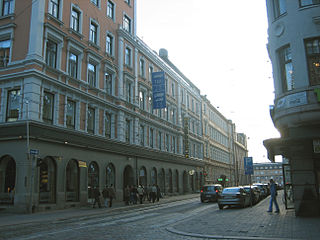
Kaisaniemi is a part of the centre of Helsinki, Finland. It is located immediately north of the Helsinki Central railway station and south of Hakaniemi. The most famous part of Kaisaniemi is the Kaisaniemi park, a park covering many hectares right in the city centre. Kaisaniemi is part of the Vironniemi district and neighbourhood of Kluuvi.

Laakso is a neighbourhood in Helsinki, Finland. Its borders are defined by the streets of Mannerheimintie and Nordenskiöldinkatu and the Helsinki Central Park. The neighbourhood is bordered by Töölö in the south, Meilahti in the southwest, Ruskeasuo in the north and Länsi-Pasila in the east.
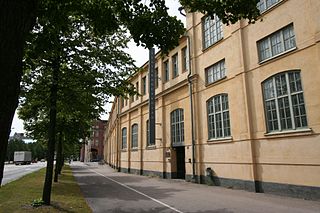
The Theatre Academy is one of the three academies of the University of the Arts Helsinki and offers education in theatre and dance. It is Finland's largest education provider in its field and, with the exception of acting, the only one in the country. In September 2014, there were 349 students at TeaK: 315 in the bachelor and master programmes, and the remaining 34 were studying for a licentiate or doctoral degree.
Lapinlahti is a quarter in Helsinki, part of the Länsisatama neighbourhood.

Munkkiniemi is a neighbourhood in Helsinki. Subdivisions within the district are Vanha Munkkiniemi, Kuusisaari, Lehtisaari, Munkkivuori, Niemenmäki and Talinranta.
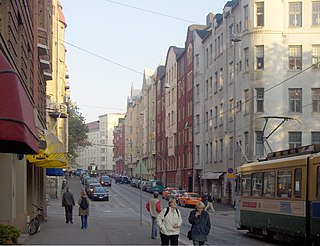
Tehtaankatu is an east-to-west street in southern central Helsinki. It leads from the border of Kaivopuisto park near South Harbour to Hietalahti shipyard. Most of the street is in Ullanlinna district, but its westernmost part forms the border between Eira and Punavuori districts.

Malmi is a regional center and a major district on the north-eastern part of Helsinki, Finland. It has a population of 24,312 (2008). The Malmi District is divided into six subareas, two of which are the center forming Ylä-Malmi and Ala-Malmi, and the rest are Pihlajamäki, Tattariharju, Malmin lentokenttä and Pihlajisto. Malmin peruspiiri is a related but distinct subdivision of Helsinki which does not include Pihlajamäki and Pihlajisto, but instead includes Tapanila and Tapaninvainio. The population of this area is approximately 27,800.

The Alexander Theatre is a Finnish theatre in the city of Helsinki at Bulevardi 23–27, also known as Russian Theatre.
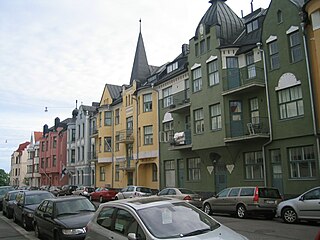
Ullanlinna is a city district of Helsinki, in Finland. The name Ullanlinna refers to the fortification line that was built at the southern edge of the area during the 18th century, as part of the town fortifications, which also included the fortress of Suomenlinna. The name Ulla refers to the Swedish Queen Ulrika Eleonora (1688–1741). During the 19th century the area was dominated by summer pavilions owned by the wealthy Helsinki middle-classes. The appearance of the area changed gradually at the end of the 19th century as the wooden houses were replaced with much higher stone buildings, designed in the prevailing Jugendstil architectural style synonymous with National Romanticism.

Yrjö Aleksanteri Ollila was a Finnish Impressionist painter, designer and muralist.

The Maria Hospital was founded in Helsinki, Finland in the 19th century as a Russian military hospital. Since independence of Finland, the hospital has functioned as a hospital both of the City of Helsinki and of the hospital district of Helsinki and Uusimaa. Hospital functionalities in the Maria Hospital were discontinued in 2014. The Maria hospital has had long and close connections to the history of Finnish independence. The hospital was named after the wife of Emperor Alexander III of Russia, Maria Feodorovna. The hospital has included units for orthopedics and traumatology, urology, general and gastric surgery and a policlinic. The hospital performed surgery and even in the early 2000s performed artificial joint surgery, back surgery, trauma surgery and complicated gastric and general surgery and urology. In 2007, the hospital moved from the hospital district of Helsinki and Uusimaa mostly to the City of Helsinki, and only dialysis was performed under the central hospital of the hospital district. In its final phases, the hospital also included bed places.



















